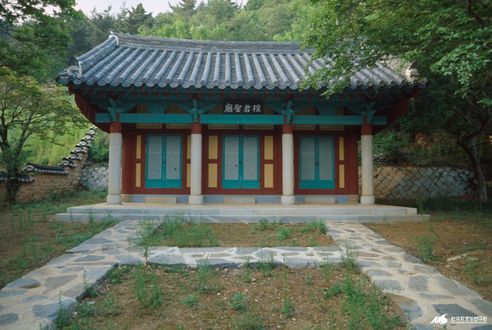"Gija: The Legend behind the Origin of Korea's Confucian Culture"의 두 판 사이의 차이
| (사용자 2명의 중간 판 5개는 보이지 않습니다) | |||
| 2번째 줄: | 2번째 줄: | ||
|Article=기자: 한국 유교 문명의 기원론 | |Article=기자: 한국 유교 문명의 기원론 | ||
}} | }} | ||
| − | |||
| − | |||
| − | |||
| − | |||
| − | |||
According to an old myth, [[단군|Dangun]], the grandson of the Lord of Heaven, founded a tribal confederation called [[고조선|Gojoseon]] somewhere in the northern Korean peninsula or Liaoning peninsula during the Bronze Age. Today, Koreans consider this to be the origin story of the Korean nation, with [[단군|Dangun]] as the ancestor of the Korean people. But some Chinese history books state that [[고조선|Gojoseon]] was established by a man named Gija from China. Who is Gija and what do Koreans say about him? | According to an old myth, [[단군|Dangun]], the grandson of the Lord of Heaven, founded a tribal confederation called [[고조선|Gojoseon]] somewhere in the northern Korean peninsula or Liaoning peninsula during the Bronze Age. Today, Koreans consider this to be the origin story of the Korean nation, with [[단군|Dangun]] as the ancestor of the Korean people. But some Chinese history books state that [[고조선|Gojoseon]] was established by a man named Gija from China. Who is Gija and what do Koreans say about him? | ||
| 16번째 줄: | 11번째 줄: | ||
<gallery mode=packed heights=220px> | <gallery mode=packed heights=220px> | ||
| + | 파일:2-1. AKS 기자도.jpg|thumb|600px|center|Painting of Gija (left)<ref>Source: 노태돈, "[http://encykorea.aks.ac.kr/Contents/Index?contents_id=E0008388 기자동래설]", <html><online style="color:purple">『한국민족문화대백과사전』<sup>online</sup></online></html>, 한국학중앙연구원.</ref> | ||
파일:1-단군 표준영정.jpg|thumb|170px|right|Portrait of Dangun<ref>Source: "[http://www.kculture.or.kr/korean/portrait/portraitView.jsp?sp_seq=18 단군]", 선현의 표준영정, <html><online style="color:purple">『한민족정보마당』<sup>online</sup></online></html>, 한국문화정보원.</ref> | 파일:1-단군 표준영정.jpg|thumb|170px|right|Portrait of Dangun<ref>Source: "[http://www.kculture.or.kr/korean/portrait/portraitView.jsp?sp_seq=18 단군]", 선현의 표준영정, <html><online style="color:purple">『한민족정보마당』<sup>online</sup></online></html>, 한국문화정보원.</ref> | ||
파일:2-1. AKS 옥구향교 단군성묘.jpg|Shrine for Dangun at Okguhyanggyo Local Confucian School<ref>Source: 김호일, "[http://encykorea.aks.ac.kr/Contents/Index?contents_id=E0038672 옥구향교]", <html><online style="color:purple">『한국민족문화대백과사전』<sup>online</sup></online></html>, 한국학중앙연구원.</ref> | 파일:2-1. AKS 옥구향교 단군성묘.jpg|Shrine for Dangun at Okguhyanggyo Local Confucian School<ref>Source: 김호일, "[http://encykorea.aks.ac.kr/Contents/Index?contents_id=E0038672 옥구향교]", <html><online style="color:purple">『한국민족문화대백과사전』<sup>online</sup></online></html>, 한국학중앙연구원.</ref> | ||
</gallery> | </gallery> | ||
| + | |||
| + | <gallery mode=packed heights=220px> | ||
| + | File:001(E).jpg|Gojoseon | ||
| + | </gallery> | ||
| + | |||
| + | =='''Related Articles'''== | ||
| + | *[[Gojoseon|Gojoseon (古朝鮮)]] | ||
| + | *[[Dangun|Dangun (檀君)]] | ||
| + | *[[Book of Documents|''Book of Documents'' (尙書, ''Shangshu'')]] | ||
| + | *[[Analects|''Analects'' (論語, ''Lunyu'')]] | ||
| + | *[[Great Commentaries to the Book of Documents|''Great Commentaries to the Book of Documents'' (尙書大傳, ''Shangshu dachuan'')]] | ||
| + | *[[Records of the Grand Historian|''Records of the Grand Historian'' (史記, ''Shiji'')]] | ||
| + | *[[Memorabilia of the Three Kingdoms|''Memorabilia of the Three Kingdoms'' (三國遺事, ''Samguk yusa'')]] | ||
=='''References'''== | =='''References'''== | ||
<references/> | <references/> | ||
| − | |||
| − | |||
| − | |||
| − | |||
| − | |||
| − | |||
| − | |||
| − | |||
| − | |||
[[분류:Debates on Korea]] | [[분류:Debates on Korea]] | ||
2017년 11월 28일 (화) 20:00 기준 최신판
According to an old myth, Dangun, the grandson of the Lord of Heaven, founded a tribal confederation called Gojoseon somewhere in the northern Korean peninsula or Liaoning peninsula during the Bronze Age. Today, Koreans consider this to be the origin story of the Korean nation, with Dangun as the ancestor of the Korean people. But some Chinese history books state that Gojoseon was established by a man named Gija from China. Who is Gija and what do Koreans say about him?
Ancient Chinese records, such as the Book of Documents (尙書, Shangshu) and the Analects (論語, Lunyu) of Confucius say Gija lived in the Shang dynasty around 1000 BCE but make no mention of him going to the Korean peninsula. Gija is first described as having ruled the Korean peninsula in the Records of the Grand Historian (史記, Shiji) and Great Commentaries to the Book of Documents (尙書大傳, Shangshu dachuan), which were written after the third century BCE.
Gija first appears in Korean historical texts in the Memorabilia of the Three Kingdoms (三國遺事, Samguk yusa), written by the Buddhist master Ilyeon. From this and other records written in the Goryeo dynasty, it seems that ancient Koreans were aware of Gija. However, Gija did not loom large in the Korean consciousness until the 13th century, when foreign invasions by the Khitans and Mongols gave rise to a strong national awareness and reexamination of the tales of Gojoseon. Confucian scholars considered Gija to be important as the man who brought Chinese culture to Korea, and hence as evidence that Korea's Confucian tradition is almost as old as that of China. They referred to the period when Gija and his descendants were believed to have ruled Gojoseon (circa 1000-194 BCE) as "Gija Joseon."
In Korea today, however, neither Gija nor Gija Joseon are recognized as historical fact, considering the distance Gija would have had to travel and the dissimilarity between the bronze culture of China and Korea at the time. Regardless of whether Gija really came to Korea or not, the story of Gija demonstrates the traditional understanding of Korean Confucianism's origin and speaks to the influence of Confucianism on ancient Korean civilization.
Painting of Gija (left)[1]
Portrait of Dangun[2]
Shrine for Dangun at Okguhyanggyo Local Confucian School[3]
Related Articles
- Gojoseon (古朝鮮)
- Dangun (檀君)
- Book of Documents (尙書, Shangshu)
- Analects (論語, Lunyu)
- Great Commentaries to the Book of Documents (尙書大傳, Shangshu dachuan)
- Records of the Grand Historian (史記, Shiji)
- Memorabilia of the Three Kingdoms (三國遺事, Samguk yusa)



